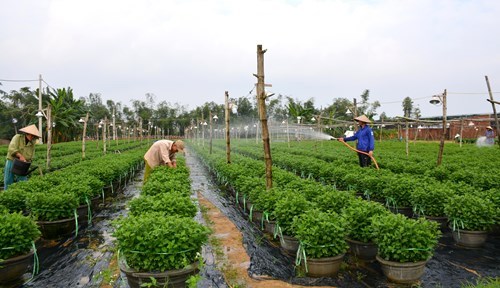Empowering poor households
The images which spring to mind of communes of the mountainous district of Hoa Vang, Da Nang city have recently changed. Many shanty homes in the past have been replaced by new and solid houses.
Nguyen Van Tai, a resident of Nam Yen village, Hoa Bac commune, said with joy, “Thanks to the support from city’s policy for the poor, our family has overcome poverty.”
Recalling his past, Tai said that his family was rated among the poorest in the village 10 years ago. In 2004, the local authority provided cattle and a loan for his family, and his family started raising cattle and he has since bought and raised some more cows and goats.
At present, his family owns an animal-husbandry farm of some 2,000sq.m, a special home and earns a good and stable income.
According to the Hoa Vang district Office of Labor, Invalids and Social Affairs, Tai is one of thousands of local people who have benefitted and succeeded in escaping poverty.
    |
 |
|
A model of planting daisy flowers in Hoa Chau commune, Hoa Van district |
Deputy-Chairman of the Da Nang Municipal People’s Committee, Vo Duy Khuong, said that the city’s poverty reduction program has benefited a large number of local poor people. Almost all the local poor have access to basic social services, such as education, healthcare and clean water.
Over the past years, the city has issued many specific policies on poverty reduction, creating favorable conditions for local businesses, armed forces, branches and authorities to mobilize all resources to support the poor directly.
The official also revealed that the city’s poverty reduction policies are changing from giving away free aid packages to supporting the poor to overcome their difficulties. These include loans without interest, technical support and supports of production means, seeds and breeders, and job creation. Furthermore, the city also focuses on improving the quality of lives of local people, building public projects in difficult communes and residential areas for poor people, providing monthly allowances for elderly and disabled people, orphans and patients with serious or chronic diseases, and offering free medical insurance cards to poor people.
These policies and approaches have helped those considered “poor” and “near poor” households overcome their difficulties step by step while ensuring their access to basic services.
Approaches to sustainable poverty reduction
According to the Da Nang Municipal Department of Labor, Invalids and Social Affairs, in 1997, the City had 850 households frequently lacking food to eat and 10,471 others rated as poor. By the end of 2000, there were neither hungry nor poor households in the city. Since then, the city has drawn up 5 poverty reduction programs for 5 periods of time, and raised its poverty standard 5 times. Particularly, the city’s poverty standard is always 20%-30% higher than the national one, and it completed the objectives on poverty reduction 2-3 years prior to the plan.
For instance, the poverty reduction program in the period 2009-15 set the poverty line of VND 400,000-500,000 per capita per month, and there were 32.796 households or 19.26% of the city’s population under this poverty line. The city finished the target by the end of 2012, or 3 years ahead of the plan. Meanwhile, 23,276 households have been listed as poor ones in its poverty reduction program in the period 2016-2020 with a poverty standard of VND 1,100,000-1,300,000 per capita per month. Up to 14,061 successfully escaped poverty in 2016 and 2017.
Deputy-Director of the Da Nang Municipal Department of Labor, Invalids and Social Affairs, Tran Cong Nguyen said that job creation is an important approach supporting poor households escape poverty in a fast and sustainable manner. The city has offered free vocational training courses and then created jobs for members of poor families over the past years, and invested in commune-based projects to support poor locals.
Ongoing effective models of job creation in the city include growing mushrooms, flowers and bonsai in Hoa Vang district, and recycling wastes to produce dishwashing and floor-cleaning liquid in Lien Chieu district. Other models also exploit local potentials and strengths as well as poor people’s qualifications to accelerate sustainable poverty reduction in their localities.
According to city’s leaders, the local 2016-20 poverty reduction program will continue to be improved to avoid shortcomings while seeking practical and sustainable outcomes and improving the quality of such services as healthcare, education, housing, hygiene, clean water and communications. Districts of the city should open more vocational training courses, create more jobs, offer livelihoods and provide more effective support for local people, particularly poor people.
Reports from its involved agencies show that the city has mobilized resources to build 7,613 new homes, repaired 4,749 homes for poor families, as well as offering preferential loans to 37,326 households, and creating 54,201 new jobs for local people. It also provided means of production for 5,401 households, gave instruction on effective methods of production and business to 75,817 people, all combined with giving free medical insurance cards to 1,171,944 needy people.
Translated by Thu Nguyen